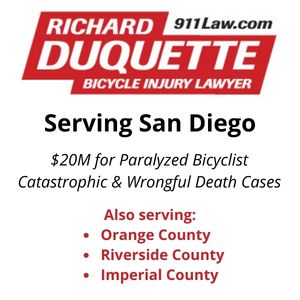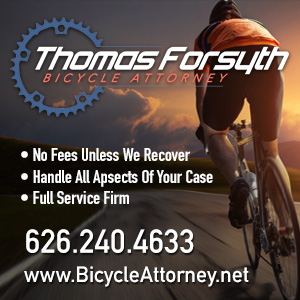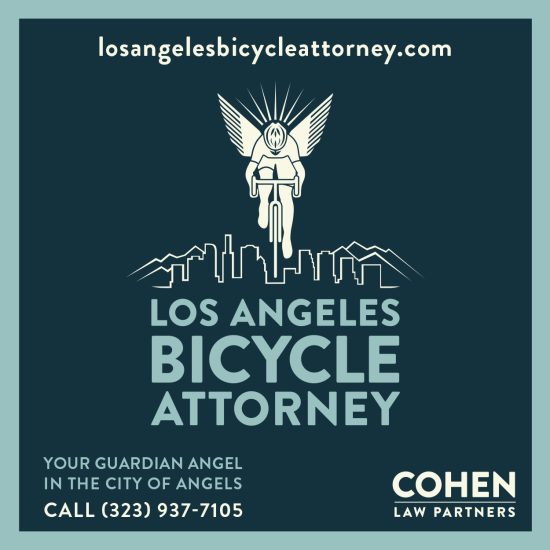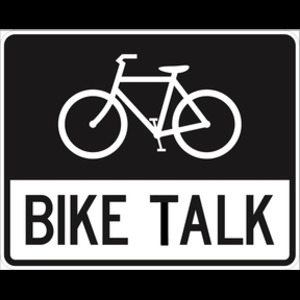I’m not a big fan of sharrows.
Yes, they have their place, providing on-street wayfinding for riders and positioning them out of the door zone, while sending a clear signal to drivers that we have a right to ride in the traffic lane.
But they don’t give us any rights to road we don’t already have, or one inch of real estate we aren’t already entitled to. And they don’t move riders out of the way of heavy traffic and impatient drivers.
The strictly vehicular crowd will tell you that sharrows are better than badly designed bike lanes that put riders in the door zone. But they are never preferable to a well-designed bike lane that safely positions riders out of traffic and away from danger.
And unlike bike lanes, sharrows do little or nothing to encourage more timid riders to take to the road.
Yet West Hollywood has decided that sharrows make more sense on heavily travelled La Brea Avenue than the long-planned bike lanes that were supposed to be installed in the next few years. And which were supposed to connect with bike lanes that will be installed on the Los Angeles portions of the street under the current bike plan.
Apparently, they’ve concluded that a wide, landscaped median that would beautify the street is more important than bike lanes that would encourage bike riding, reduce congestion and improve safety for all road users.
LACBC regional chapter West Hollywood Bicycle Coalition is leading the fight to keep bike lanes on the redesigned street. So I’ll let them take up the story from here.
Did you know that the city of West Hollywood is planning a huge redesign of La Brea Avenue? It’s is an amazing opportunity to fix a street that currently suffers from some of the worst congestion and hazardous intersections in West Hollywood. Fortunately, La Brea also enjoys a high concentration of great destinations, diverse growth, and proximity to pleasant neighborhoods. A bike lane would be an easy, inexpensive way to capitalize on West Hollywood’s easternmost assets, and effectively reduce the inconveniences of a city that’s growing by leaps and bounds.
Sound the Alarm
WeHo’s Notice of Intent to Adopt a Negative Declaration incorrectly claims that LA plans to paint sharrow stencils on La Brea. But the city of LA has proposed bike lanes — not sharrows — for La Brea Ave in its 2010 bike plan.
If West Hollywood’s portion of La Brea isn’t built with connectivity to LA’s future bike lanes, it could cost a lot of money to fix — and it could even cost lives.
Follow the Existing Guidelines
As luck would have it, the city of West Hollywood has already conducted a study that calls for bike lanes on La Brea. The recommendations of the Bicycle Task Force include the installation of Class II (that is, non-buffered) bike lanes on La Brea Ave. The report was unanimously approved by City Council in December of 2011.
La Brea bike lanes are also indicated by West Hollywood’s Climate Action Plan, the General Plan, and even the request for proposals for this very project.
Wouldn’t Bike Lanes Just Slow Traffic Down?
No. It might seem counter-intuitive at first, but when done correctly, bike lanes can help move traffic along faster.
How’s that? Well, bike lanes keep cyclists separated from faster-moving traffic, eliminating the need for cars to change lanes or suddenly slow down to pass bikes. They also reduce conflicts between bikes and cars at intersections. And dedicated lanes allow bikes to move safely forward through traffic, rather than swerving hazardously between stopped cars.
And of course, the biggest benefit of all: with more bike lanes, more people bike instead of drive, so there’s an overall reduction in traffic on the road.
Safety Over Aesthetics
What’s more important for La Brea: a giant landscaped median that simply looks nice, or bike lanes that can actually save residents’ lives?
There’s no argument that bike lanes will make La Brea safer for everyone — not just cyclists, but pedestrians and motorists, too.
When Long Beach installed bike lanes, bike accidents decreased by 80%, vehicle accidents decreased 44%, and sidewalk-riding decreased from 70% to 28%. LADOT’s own study showed that bike lanes can reduce accidents by 35%. That reduction isn’t just for cyclists — it also includes collisions between cars.
With numerous new pedestrian-oriented projects under construction on this already-busy street, bike lanes are an easy, cost-effective way to reduce accidents and injuries. If the street’s wide enough for a median, it’s wide enough for bike lanes.
So what can you do?
Contact the City of West Hollywood and let them know that we need bike lanes. The comment period for the Notice of Intent to Adopt a Negative Declaration closes very soon: 5pm on February 28.
Send your comments here:
Donn Uyeno, P.E.
Senior Civil Engineer
City of West Hollywood Department of Public Works
8300 Santa Monica Blvd, West Hollywood, CA 90069
Tel: 323-848-6457 | Fax: 323-848-6564 | Email: duyeno@weho.orgAnd of course, follow us on Facebook, Twitter, and email newsletter to get updates on our progress with this and other projects.
West Hollywood has just one more week to get the redesigned La Brea Avenue right the first time. So take a moment to take a stand for a safer, complete bike network that would benefit everyone on what is currently one of the area’s busiest and most dangerous streets.
I’ll be emailing them before the week is over. And I hope you’ll join me.
One other brief note.
The West Hollywood Bicycle Coalition is one of the area’s most dedicated and effective groups fighting for better bicycling in the Los Angeles area. If you live or ride in West Hollywood, you owe it to yourself to get involved with them; if you’re an LACBC member, you automatically qualify for membership.
If not, what are you waiting for?







